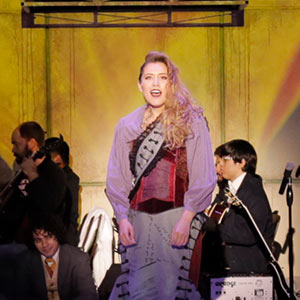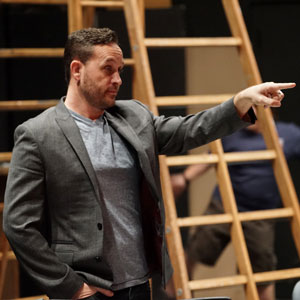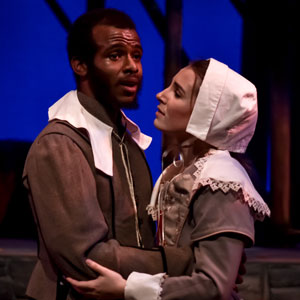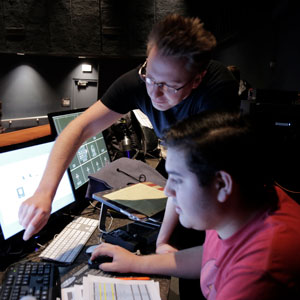Fullerton College Theater goes absurd with “Dogg’s Hamlet, Cahoot’s Macbeth”
— Fullerton College Hornet - Kevin Christensen - Tuesday, May 17th, 2016Imagine being a foreigner in a universe where although the words are familiar—brick, cube, daisy, artichoke—their definitions are entirely different. This is the world that Easy, played by Lizzie MacCabe, discovers upon delivery of her shipment of large white opaque cubes and rectangular prisms.
In “Dogg’s Hamlet, Cahoot’s Macbeth,” the audience is drawn into the universe of Tom Stoppard’s “un-identical twin plays” as director Jessica Runde likes to refer to them. Her reasoning can be taken from the introduction of the script, which refers to how the first play—“Dogg’s Hamlet”—is necessary to the second—“Cahoot’s Macbeth”—and the second is necessary to the first, hence the comma between the two in the title of the show.
Runde isn’t a stranger to Theatre of the Absurd, as her side company—Alchemy Theatre Company—will be performing Samuel Beckett’s titular piece of theatrical literature “Waiting for Godot” at Theatre of Note for Hollywood Fringe in June later this year.
Inquiring as to why she decided to choose “Dogg’s Hamlet, Cahoot’s Macbeth” for the spring workshop theatre show this year at Fullerton College, she explained that not only does the show have many roles for students to fill, but it is very much a comedy—something needed in a fairly dark season—as well as it presents many challenges for the student actors.
familiar—brick, cube, daisy, artichoke—their definitions are entirely different. This is the world that Easy, played by Lizzie MacCabe, discovers upon delivery of her shipment of large white opaque cubes and rectangular prisms.
In “Dogg’s Hamlet, Cahoot’s Macbeth,” the audience is drawn into the universe of Tom Stoppard’s “un-identical twin plays” as director Jessica Runde likes to refer to them. Her reasoning can be taken from the introduction of the script, which refers to how the first play—“Dogg’s Hamlet”—is necessary to the second—“Cahoot’s Macbeth”—and the second is necessary to the first, hence the comma between the two in the title of the show.
Runde isn’t a stranger to Theatre of the Absurd, as her side company—Alchemy Theatre Company—will be performing Samuel Beckett’s titular piece of theatrical literature “Waiting for Godot” at Theatre of Note for Hollywood Fringe in June later this year.
Inquiring as to why she decided to choose “Dogg’s Hamlet, Cahoot’s Macbeth” for the spring workshop theatre show this year at Fullerton College, she explained that not only does the show have many roles for students to fill, but it is very much a comedy—something needed in a fairly dark season—as well as it presents many challenges for the student actors.
Challenging show” could be considered an understatement if the audience is unaware of the time and commitment that acting requires. For, much like Shakespeare, in many senses is a foreign language to the average person, so is “Dogg’s Hamlet.”
The show consists of many levels, from the “play-within-a-play” level (a commonality to many Shakespearian plays—including “Hamlet” itself) to the language of “Dogg” (spoken at one point or another by all the actors) to playing players who speak “Dogg” as their primary language while trying to perform a reduced rendition of Hamlet in Shakespearian English—to which they consistently butcher the pronunciations of certain words and phrases.
The combination of all of these “levels” is reminiscent of the combination of Reduced Shakespeare Company’s “Complete Works of William Shakespeare Abridged” meets “The Twilight Zone” meets “Lost in Translation,” and as one could imagine, hilarity ensues.
Despite the challenges Stoppard presented to his actors with such a dense script, the performers commitment to quality theatre truly becomes apparent in the relationships developed between the characters. The language of “Dogg” and its unfamiliarity subsides as the play progresses and the physicality really takes a center stage helping the audience navigate the plot.
Obviously when the characters do their rendition of “Hamlet” anyone familiar with the story will be able to follow along, but the plot of “Hamlet,” really takes a back seat to the relationship of the characters present and as such the audience is able to detach from their cognition, and allow the characters to draw them in on their journey.
Much like the theater masks or yin and yang, “Cahoot’s Macbeth” compliments “Dogg’s Hamlet” with its dark charismatic charm. Following a brief intermission, act two—or “Cahoot’s Macbeth”—begins with bang—or better described as a crash. The audience is transported to the Living room of Hostess, played by Emily Boliver, as a theatre company performs a secret production of “Macbeth” written by Pavel Cahoot, played by Darren Barrett.
The audience is made out to be the attendees of the production as the secret production is first crashed by the impetuous police inspector, played by Elizabeth Hernandez, who is on the warpath to silence any acts against “normalization.”
Later, the production is also interrupted by Easy, who—once again—is attempting to deliver a shipment of large opaque cubes and rectangular prisms, while being lost in translation. As she has now caught the language of “Dogg” and cannot understand english.
Although “Cahoot’s Macbeth” has many similarities to its sibling “Dogg’s Hamlet,” it very much presents a different picture and addresses its audience in a significantly more serious tone. Runde explained that the piece asks us to recognize and be thankful of our freedoms and liberties as well as not be afraid to speak out against repressive rule. She explains that it can be easy to become comfortable when one feels safe.
“Cahoot’s Macbeth” was inspired by Stoppard’s friendship with Pavel Kohout a novelist and playwright who experienced repression by the Czechoslovakian police in the 1970s because of his involvement in Charter 77. Kohout, with other dissident theater workers, performed Living Room Theatre productions including a rendition of “Macbeth.” Although this particular production of “Macbeth” is not an exact replica of Kohout’s production, “Stoppard is like Shakespeare, he is terrible at coming up with new plots,” Runde explains with a chuckle.
But the message of “Cahoot’s Macbeth” is one which the audience members should take to heart. Art by its nature, is dangerous because art challenges its viewer. From satirical theater to insurgent theater, it is necessary that the freedom of speech and language is not traded for faux-safety and faux-comfort. Language may have the potential to cause discomfort, or even anger—but it is a necessity to challenge the status quo. Kohout was a revolutionary who recognized this and took action regardless of the risks involved.
Despite “Cahoot’s” mostly serious tone, it is also not without its humorous moments. The Police Inspectors interaction with Landovsky/Macbeth, played by Corry Chapman as well as Vlastra Chramostova/Lady Macbeth, played by Krystal Navarro, and Easy, lend for some wonderful situational humor that, on occasion, even flirts with being farcical.
Finally, the concoction of technical theater magic, as seen in wonderfully expressionistic light design by Steve Pliska, fantastically geometric set design by Kevin Clownes (reminiscent of Braque and Picasso), and fabulous costume design ranging the gambit of period Shakespearian to modern dress by Mela Hoyt-Heydon, provide just the right ingredients for a visually entertaining night. And the combination of the two plays metaphorically stirred together with three witches chanting “Double, double toil and trouble; Fire burn, and cauldron bubble,” huddled around a big black cauldron, provides for a memorable night of theatre that is sure to open the door to fierce post-show discussion amongst those who attend.
The Fullerton College production of Dogg’s Hamlet, Cahoot’s Macbeth runs May 12, 13, and 14 at 7pm and May 15 at 2pm in the Bronwyn Dodson Theatre. Tickets are $12.50 Presale or $15.00 at the Door.








